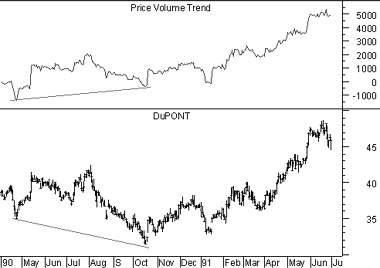|
PRICE AND VOLUME TREND
Overview
The Price and Volume Trend ("PVT") is similar to On Balance Volume
(OBV) in that it is a cumulative total of volume that is
adjusted depending on changes in closing prices. But where OBV adds all volume on days
when prices close higher and subtracts all volume on days when prices close lower, the PVT
adds/subtracts only a portion of the daily volume. The amount of volume added to the PVT
is determined by the amount that prices rose or fell relative to the previous day's
close.
Interpretation
The interpretation of the Price and Volume Trend is similar to the interpretation of
On Balance Volume and the
Volume Accumulation/Distribution Line.
Many investors feel that the PVT more accurately illustrates the flow of money into and
out of a security than does OBV. This is because OBV adds the same amount of volume to the
indicator regardless of whether the security closes up a fraction of a point or doubles in
price. Whereas, the PVT adds only a small portion of volume to the indicator when the
price changes by a small percentage and adds a large portion of volume to the indicator
when the price changes by a large percentage.
Example
The following chart shows Dupont and the
PVT.
 The bullish divergence (the PVT was trending higher while prices trended lower) was
followed by a strong price increase.
The bullish divergence (the PVT was trending higher while prices trended lower) was
followed by a strong price increase.
Calculation
The PVT is calculated by multiplying the day's volume by the percent that the security's
price changed, and adding this value to a cumulative total.

For example, if the security's price increased 0.5% on volume of 10,000 shares, we would
add 50 (i.e., 0.005 * 10,000) to the PVT. If the security's price had closed down 0.5%, we
would have subtracted 50 from the PVT.
|

